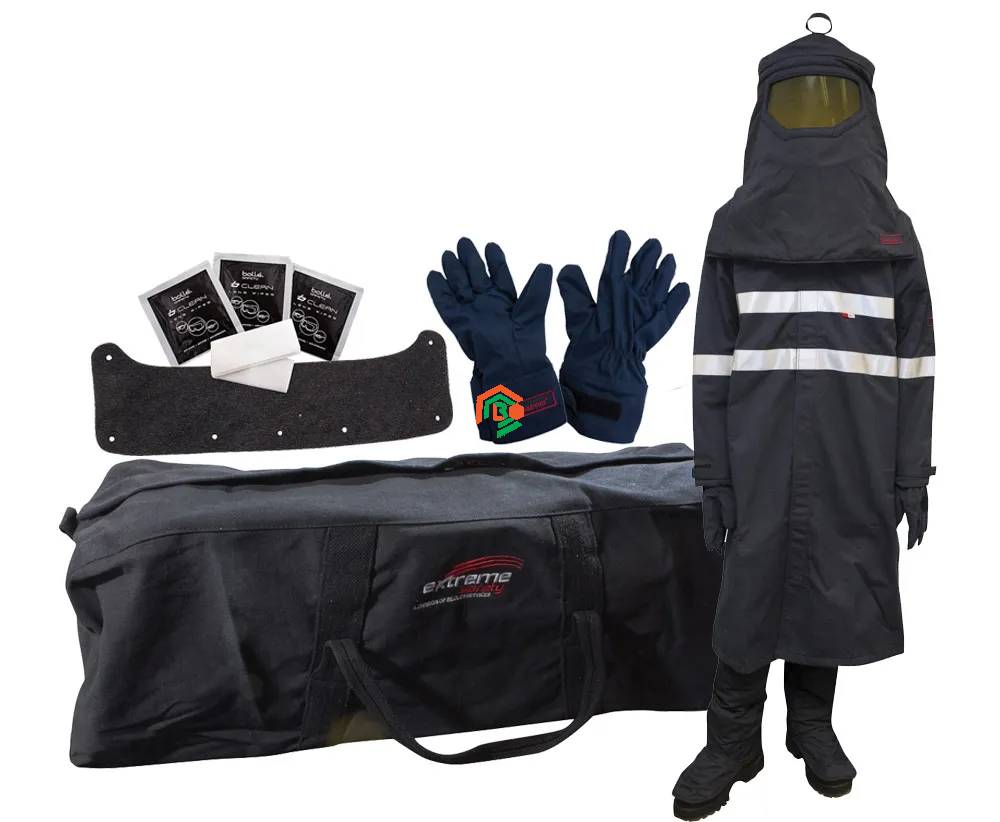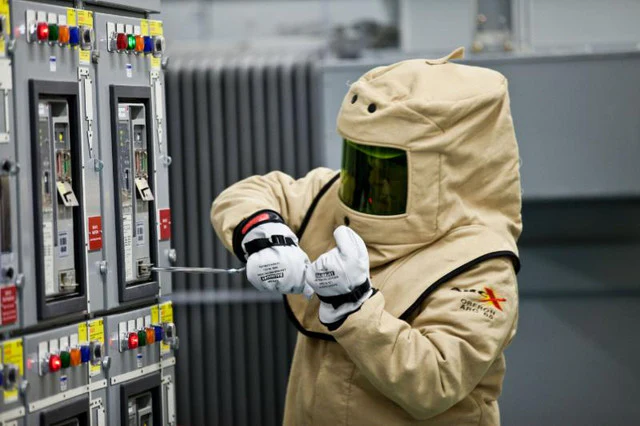If you’ve ever seen electricians working with big power systems, you may have noticed they wear a special suit. That’s called an arc flash suit. But what exactly is it, and why is it so important? Let’s break it down in a simple way anyone—even kids—can understand.
What Is an Arc Flash Suit?
An arc flash suit is a special type of protective clothing made for people who work around high-voltage electricity. This includes electricians, linemen, engineers, and anyone working in power stations or industrial settings. The suit is designed to protect the person wearing it from something very dangerous: an arc flash.
So, what’s an arc flash? It’s a sudden burst of electricity that jumps through the air from one connection to another. Imagine lightning, but much closer and more intense. Arc flashes can cause serious burns, fires, even explosions. They can reach temperatures of over 35,000°F, hotter than the surface of the sun!
That’s where the arc flash suit comes in. It acts like a shield, keeping the worker safe from heat, fire, and electrical shock.
Why Do Electricians Need This Suit?
Electricians and utility workers often deal with equipment that carries thousands of volts. If there’s even a small mistake—like touching the wrong wire or dropping a tool—it can trigger an arc flash. Without protection, a person can suffer severe injuries within a fraction of a second.
Even trained professionals can make small mistakes. That’s why wearing an arc flash suit is not optional—it’s a critical safety requirement. OSHA (Occupational Safety and Health Administration) and NFPA 70E (National Fire Protection Association) both require workers in certain environments to wear arc-rated protective clothing.
In short, electricians need this suit because accidents can happen, and it’s always better to be safe than sorry.
What Is Inside an Arc Flash Suit?
Arc flash suits are not just simple overalls. They are made with layers of advanced materials like Kevlar, Nomex, and other flame-resistant (FR) fabrics. Each piece of the suit works together to protect every part of the worker’s body from electrical burns, heat, and flying debris.

Let’s take a closer look at the main parts of an arc flash suit.
Helmet and Face Shield
The helmet is often made of a strong, impact-resistant plastic and comes with a face shield. The face shield is usually tinted and made from a material that can withstand high temperatures. It protects the face and eyes from intense light, flying particles, and heat during an arc flash.
Some advanced suits also include a hood or balaclava, which wraps around the head and neck to offer extra protection.
Jacket and Pants
The jacket and pants are made from multiple layers of arc-rated flame-resistant fabrics. These materials don’t catch fire easily and help block the heat from reaching the skin. The jacket is long-sleeved and usually fastens with Velcro or snaps, not zippers, which could melt.
The pants go all the way to the boots, making sure there are no gaps where heat or flames can get in. Some suits come as a coverall—a single piece of clothing that you step into like a jumpsuit.
Gloves and Boots
Hands and feet are also at high risk during an arc flash. That’s why the suit includes rubber-insulated gloves (sometimes layered with leather for extra protection). These gloves keep electricity from passing through the hands.
The boots are typically made of rubber or leather, often with non-conductive soles, so that electricity can’t pass through to the ground.
How Does the Suit Keep You Safe?
The arc flash suit protects you in several ways, all working together at once:
- Heat Resistance: The materials can resist extremely high temperatures without melting or catching fire.
- Insulation: The layers help block or slow down heat from reaching the skin.
- Electric Shock Protection: Insulated gloves and boots reduce the chance of electrical shock.
- Durability: The fabric can withstand blasts, flying debris, and fireballs.
- Arc Rating: Every suit has an arc thermal performance value (ATPV) or energy break-open threshold (EBT) rating, showing how much energy it can handle before breaking down.
Wearing this suit can mean the difference between walking away or being seriously hurt during an arc flash incident.
Different Types of Arc Flash Clothing
Not every job needs the same level of protection. That’s why arc flash clothing comes in different types, based on Category ratings (CAT) or calories per square centimeter (cal/cm²). The higher the number, the more protection the suit offers.
Here are the main categories:
- CAT 1 (4 cal/cm²): Basic protection; long-sleeve FR shirt and pants.
- CAT 2 (8 cal/cm²): Moderate protection; often used in commercial settings.
- CAT 3 (25 cal/cm²): For higher-risk work; usually includes full arc flash suit.
- CAT 4 (40 cal/cm² and above): Maximum protection; used for extremely high-risk environments.
The right category depends on the risk level of the electrical work. A full arc flash suit is usually required for CAT 3 and CAT 4 environments.
How to Choose the Right Arc Flash Suit
Buying an arc flash suit is not like buying regular clothes. You have to consider many factors to make sure you’re fully protected. Here’s what to look for:

Check the Safety Rating
Every suit should come with a label showing its arc rating (cal/cm²). This tells you how much energy it can withstand. You need to match this with the incident energy of the electrical system you’re working on. Always choose a suit with a rating equal to or higher than the risk.
Look for certifications like:
- NFPA 70E Compliant
- ASTM F1506 Standard
- OSHA Approved
Make Sure It Fits
A suit that’s too tight can be dangerous because it may not allow airflow, which helps keep you cool and safe. On the other hand, a suit that’s too loose can catch on tools or equipment.
Choose a suit that allows easy movement, is breathable, and fits properly over your regular clothes or FR base layer.
Look for Real Brands
Cheap, no-name brands may not give you the protection you need. Look for trusted names in the industry such as:
- Oberon
- NSA (National Safety Apparel)
- Chicago Protective Apparel
- Salisbury by Honeywell
Buying from certified manufacturers ensures that your suit meets real safety standards and has been tested under strict conditions.
How to Wear It the Right Way
Wearing an arc flash suit isn’t just about putting it on—it’s about putting it on correctly. Make sure:
- All fasteners are fully closed (Velcro, snaps, etc.)
- Gloves go over the cuffs of the jacket
- Pants cover the top of the boots
- The face shield is down and locked in place
- No skin is exposed anywhere
Also, make sure the suit is clean and in good condition. Dirt, oil, or damage can reduce its ability to protect you. Always inspect your gear before use.
The Bottom Line
An arc flash suit might look like something out of a sci-fi movie, but it’s a real and essential part of working safely with electricity. It’s designed to protect against some of the most dangerous hazards on the job, including intense heat, fire, and electric shock.
Electricians and utility workers wear these suits because the risk is very real—and protection matters. Whether you’re in a commercial building, a power plant, or out fixing electrical lines, this suit can save lives.
Remember, when it comes to electrical safety, the right gear makes all the difference. And understanding how to choose it, wear it, and care for it is something everyone should know—even kids!


